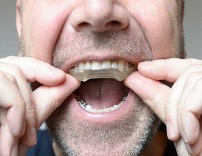TEETH GRINDING AT NIGHT AND THERAPY
Teeth clenching and grinding (bruxism) burdens the teeth much more than chewing food. It most often occurs in sleep. Every fifth person is affected by bruxism and its consequences.
Teeth grinding causes damage such as cracking of tooth enamel, abrasion of teeth, and tearing of teeth, ie. enamel loss. Such damage often causes a decrease in the height of the bite, and thus various destructive phenomena in the jaw joint and pain in the temporomandibular region, ie. region around the joint. Another pathological change that accompanies bruxism occurs in the masticatory muscles and the surrounding muscles of the head and occurs as a consequence of their overexertion. Muscle tension causes dull, dull headaches, usually in the area of the jaw joint, temple, and back of the head.
Therapy involves making a special splint by the dentist that the patient wears while sleeping. Pain most often disappears after six months of wearing a splint. The goal of this therapy is to protect the teeth from grinding, the splint acts as an insulator that prevents contact between the teeth of the lower and upper jaw. There are several types of splints such as Michigan splint, NTI-tss and Erkoloc. Erkoloc splints are very popular because of the speed of manufacture and the thickness of only 2mm, which any jaw joint could accept.
It should be emphasized that splint therapy does not stop further teeth gnashing and clenching, but prevents the onset of pain and abrasion of the teeth, which is why splints should be worn even after the discomfort disappears.
Contact our Dur Dental team for more information and personalized advice.




